What is a Training and Development Cover Letter
A Training and Development cover letter is a crucial document that accompanies your resume when applying for roles in the field of training and development. It serves as a personalized introduction, allowing you to showcase your relevant skills, experience, and enthusiasm for the position. Unlike a resume, which provides a factual overview of your qualifications, a cover letter offers an opportunity to express your personality, explain your career goals, and demonstrate how your unique capabilities align with the specific requirements of the job and the values of the company. It’s your first impression, and it needs to make a strong impact.
Purpose of a Training & Development Cover Letter
The primary purpose of a Training & Development cover letter is to persuade the hiring manager that you are the ideal candidate for the role. It allows you to highlight the aspects of your background that are most relevant to the position, such as your experience in designing and delivering training programs, your knowledge of learning methodologies, and your ability to assess training effectiveness. Moreover, a well-crafted cover letter demonstrates your communication skills, attention to detail, and genuine interest in the organization and the specific opportunity. It’s about making a connection and showing that you’re not just qualified, but also a great fit for the company culture.
Key Components of a Training & Development Cover Letter
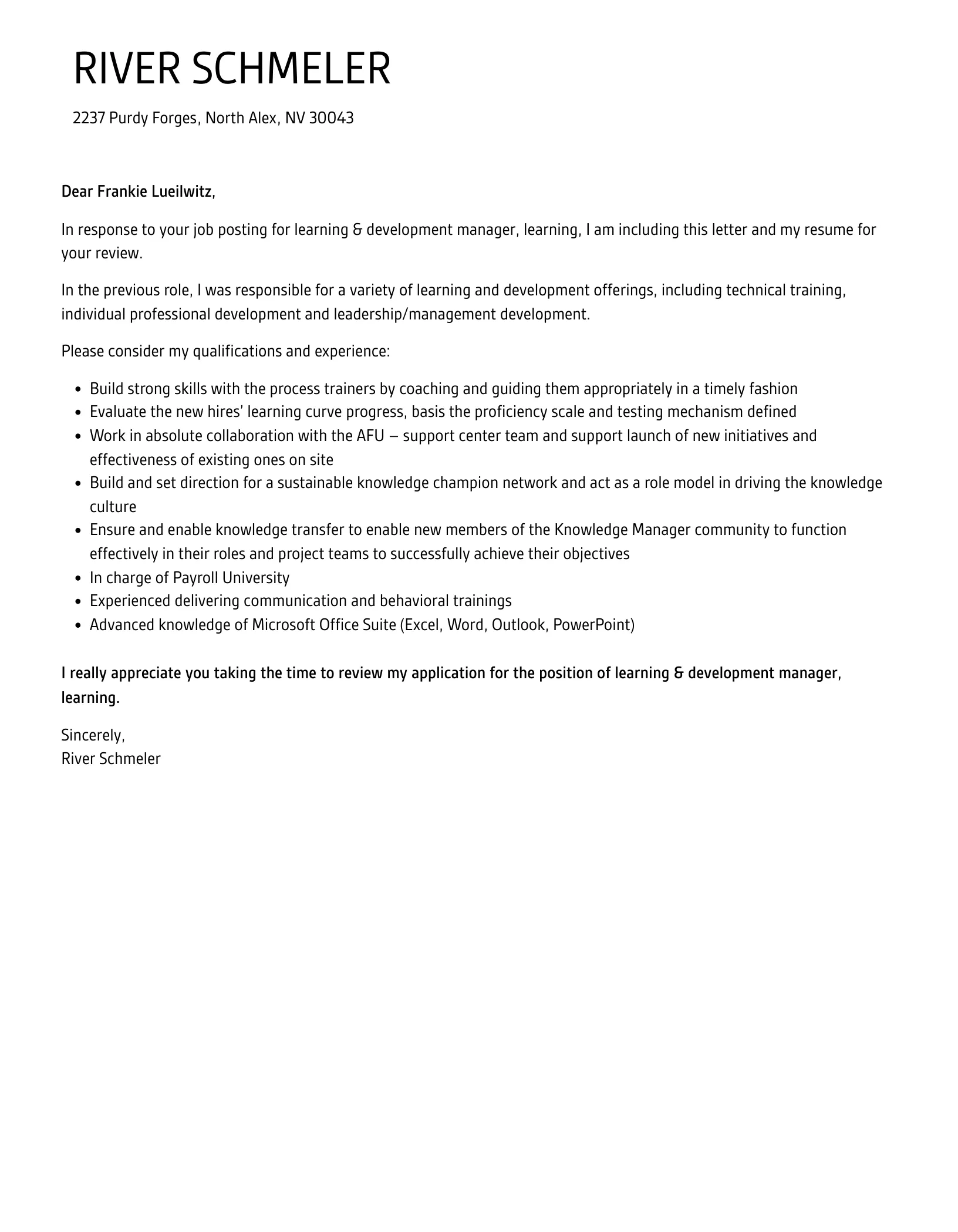
Header Information
The header of your cover letter is the first thing a hiring manager will see, and it sets the stage for the rest of the document. It should be clear, professional, and easy to read. A well-formatted header provides essential contact information and establishes the sender and recipient of the letter. It’s also important to ensure the header is visually appealing, as this demonstrates your attention to detail and professionalism. Accuracy and formatting consistency are key to making a good first impression.
Applicant’s Contact Information
At the top of your cover letter, include your full name, address, phone number, and professional email address. Ensure that the email address sounds professional; avoid using nicknames or informal language. This section ensures the hiring manager can easily contact you if they want to move forward with your application. This information should be consistently formatted and easy to read. Using a clear font and concise layout enhances readability and allows the recruiter to easily access the necessary information.
Hiring Manager’s Contact Information
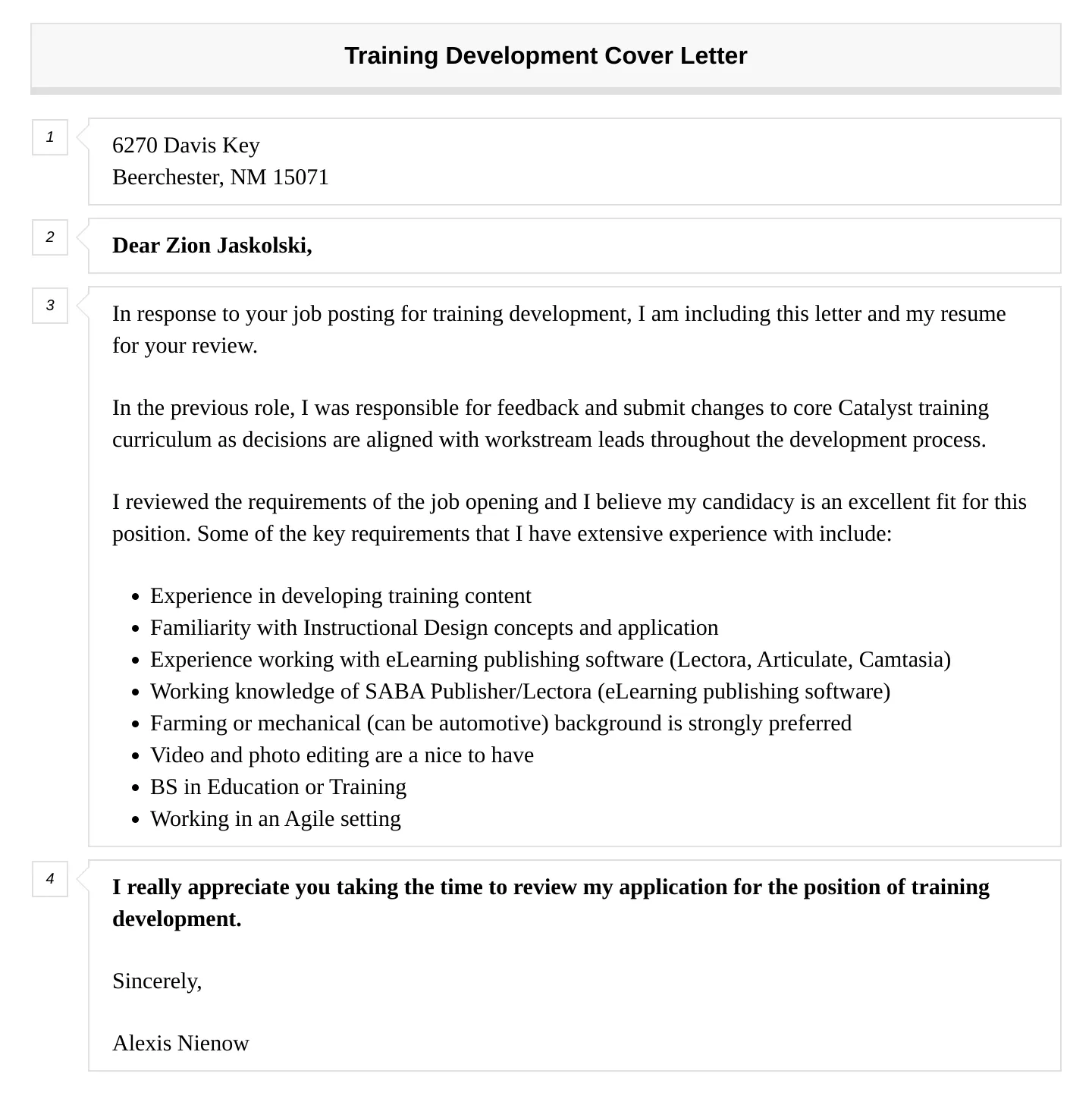
Below your contact information, include the hiring manager’s name, title, and the company’s address. If you can find the hiring manager’s name, it shows that you have put in extra effort and personalize the letter. If you are unable to find the hiring manager’s name, you can use a general title such as “Hiring Manager” or “Recruiting Team.” This demonstrates your attention to detail and helps establish a more direct connection with the recipient. Always double-check the information for accuracy.
Greeting
The greeting is the opening of your cover letter and sets the tone for the rest of your message. A well-crafted greeting can grab the hiring manager’s attention and make them want to continue reading. It’s crucial to maintain a professional and respectful tone. The right greeting creates a positive first impression and shows that you understand and respect the organization’s norms.
Formal Greetings
Use formal greetings, such as “Dear Mr./Ms./Mx. [Last Name]” if you know the hiring manager’s name. If you are unsure of the hiring manager’s name, use a general greeting such as “Dear Hiring Manager” or “Dear [Company Name] Recruiting Team.” Avoid informal greetings like “Hi” or “Hello.” Using a formal greeting demonstrates respect and professionalism, which can set a positive tone for your entire application. Ensure the correct spelling of the recipient’s name; a misspelled name can create a negative first impression.
Addressing Specifics
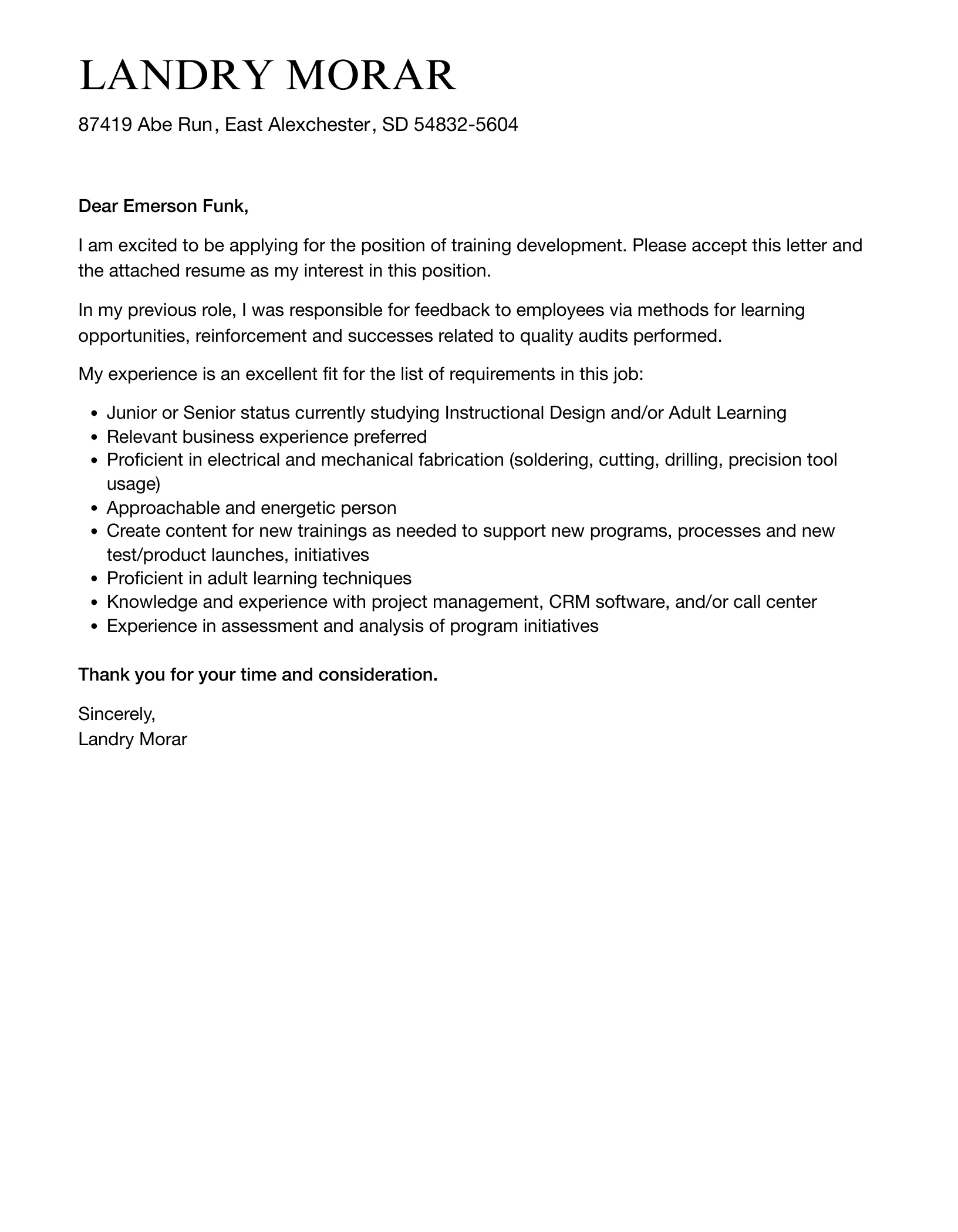
If the job posting specifies a particular contact person or department to send the application to, ensure you address the cover letter appropriately. Using the specific contact details provided in the job posting shows that you have carefully read and followed instructions. This attention to detail can significantly increase your chances of being noticed. Customizing your greeting to the job posting ensures your letter resonates with the hiring manager.
Body Paragraphs
The body paragraphs are the heart of your cover letter. They should clearly and concisely convey your qualifications, experience, and enthusiasm for the position. Each paragraph should have a specific purpose, whether it’s expressing your interest, highlighting your key skills, demonstrating your achievements, or encouraging a call to action. Use strong action verbs and provide concrete examples to illustrate your points. This section is an opportunity to make a compelling case for why you are the best candidate.
First Paragraph
Start your first paragraph by clearly stating the position you are applying for and where you found the job posting. Express your genuine interest in the role and the company. Mentioning the company’s name in your introduction is a great way to show that you have targeted the letter. Keep your opening concise and engaging, focusing on why you are interested in the specific opportunity. This helps capture the hiring manager’s attention and sets the stage for the rest of your letter. It is also good to make a statement of what you bring to the table.
Expressing Interest
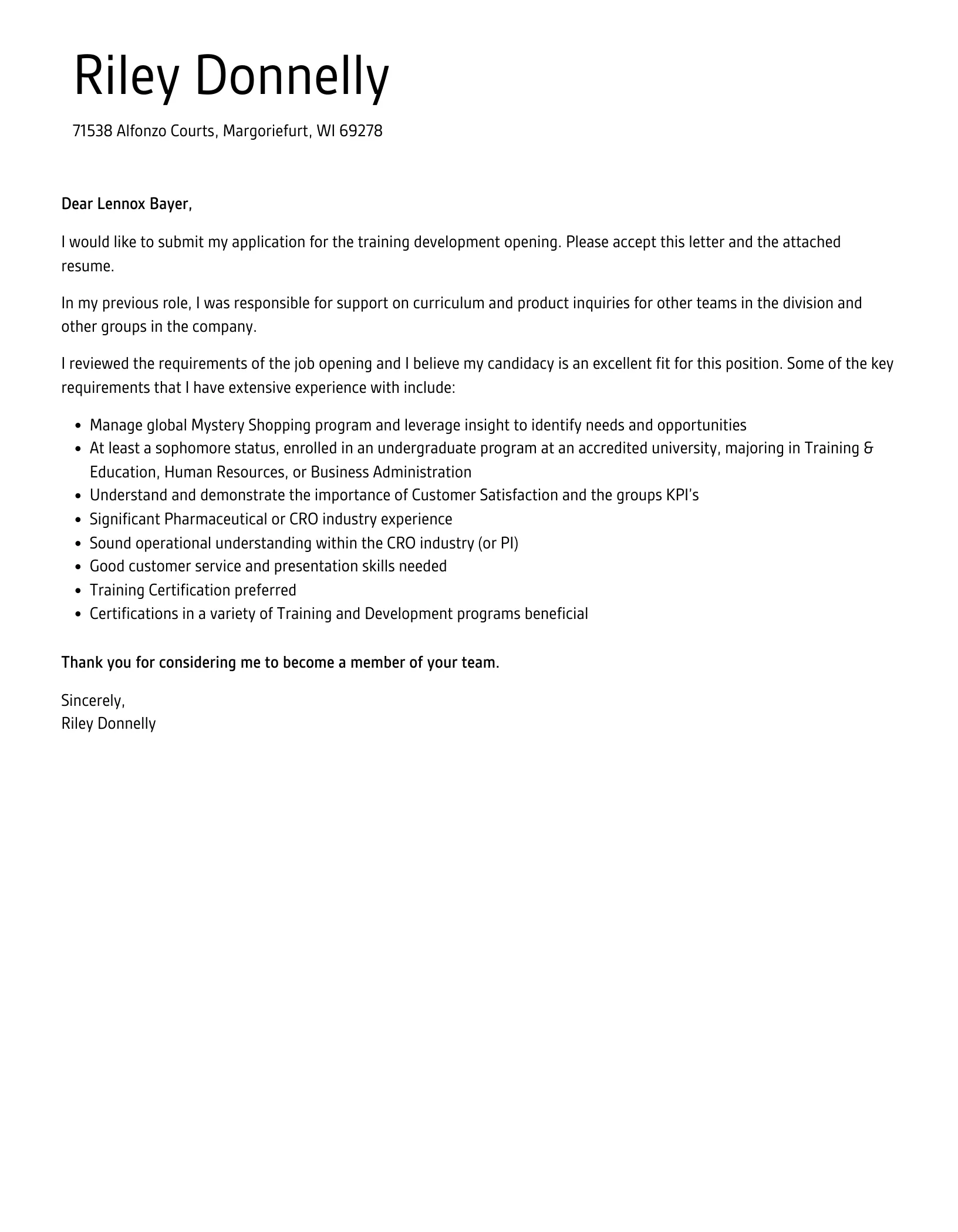
Express your enthusiasm for the position and the company in a genuine and specific way. Explain what interests you about the role and what excites you about working for the organization. Showing that you’ve researched the company and understand its mission and values is crucial. It makes you seem more invested in the company’s success and shows a genuine interest in the role. Avoid generic statements; provide specific reasons for your interest.
Highlighting Key Skills
Identify and highlight the key skills and qualifications that align with the job requirements. Use the job description as a guide, and tailor your skills accordingly. Mention the skills and experience that demonstrate your suitability for the role. Make sure to include skills mentioned in the job description. Show how your skills and experience make you a strong fit for the position. Provide concise, relevant details that resonate with the hiring manager.
Second Paragraph
This paragraph is where you provide supporting evidence of your skills and qualifications. The second paragraph is your opportunity to highlight your accomplishments and provide tangible evidence of your abilities. Support your claims with specific examples from your work experience. This allows you to demonstrate the impact you have made in previous roles. By quantifying your achievements and demonstrating the value you can bring to the company, you will set yourself apart from other applicants.
Quantifiable Achievements
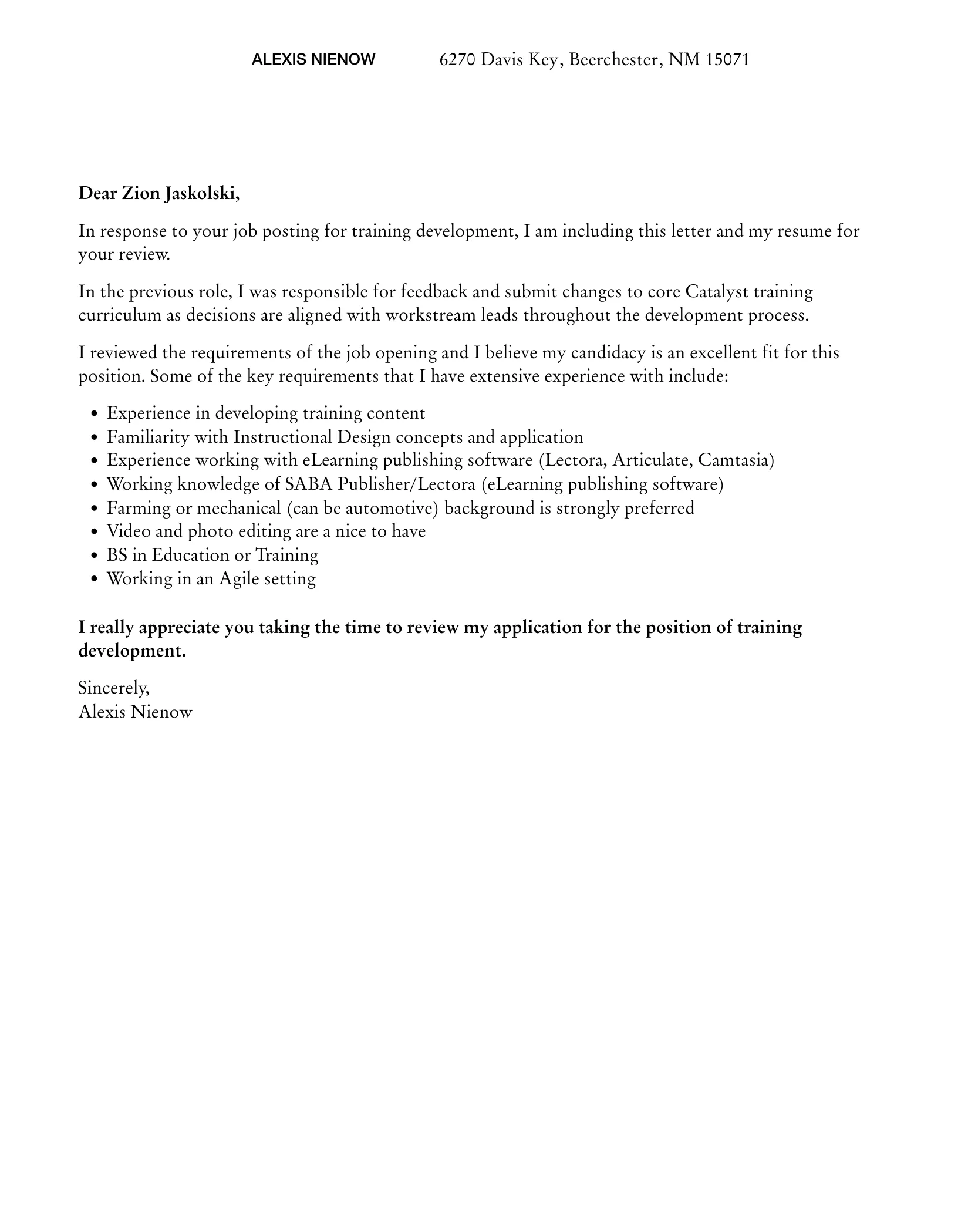
Quantify your achievements whenever possible. Use numbers, percentages, and specific metrics to demonstrate the impact of your work. This makes your accomplishments more compelling and helps the hiring manager understand the value you brought to previous roles. For example, mention how you increased training program efficiency by a certain percentage or reduced employee turnover through your training initiatives. This level of detail provides a clear picture of your capabilities and potential.
Demonstrating Value
Focus on demonstrating the value you can bring to the company. Explain how your skills, experience, and achievements align with the company’s goals and objectives. Emphasize the benefits of hiring you, such as improved employee performance, increased productivity, or enhanced training effectiveness. Show the hiring manager how your presence can contribute to the company’s success. Always align your achievements with the company’s needs.
Third Paragraph
The third paragraph should wrap up your letter and include a call to action. Summarize your key qualifications and reiterate your interest in the position. End your cover letter with a clear and confident call to action, encouraging the hiring manager to contact you for an interview. It’s also a great place to thank the hiring manager for their time and consideration. Keep the tone professional and enthusiastic.
Call to Action
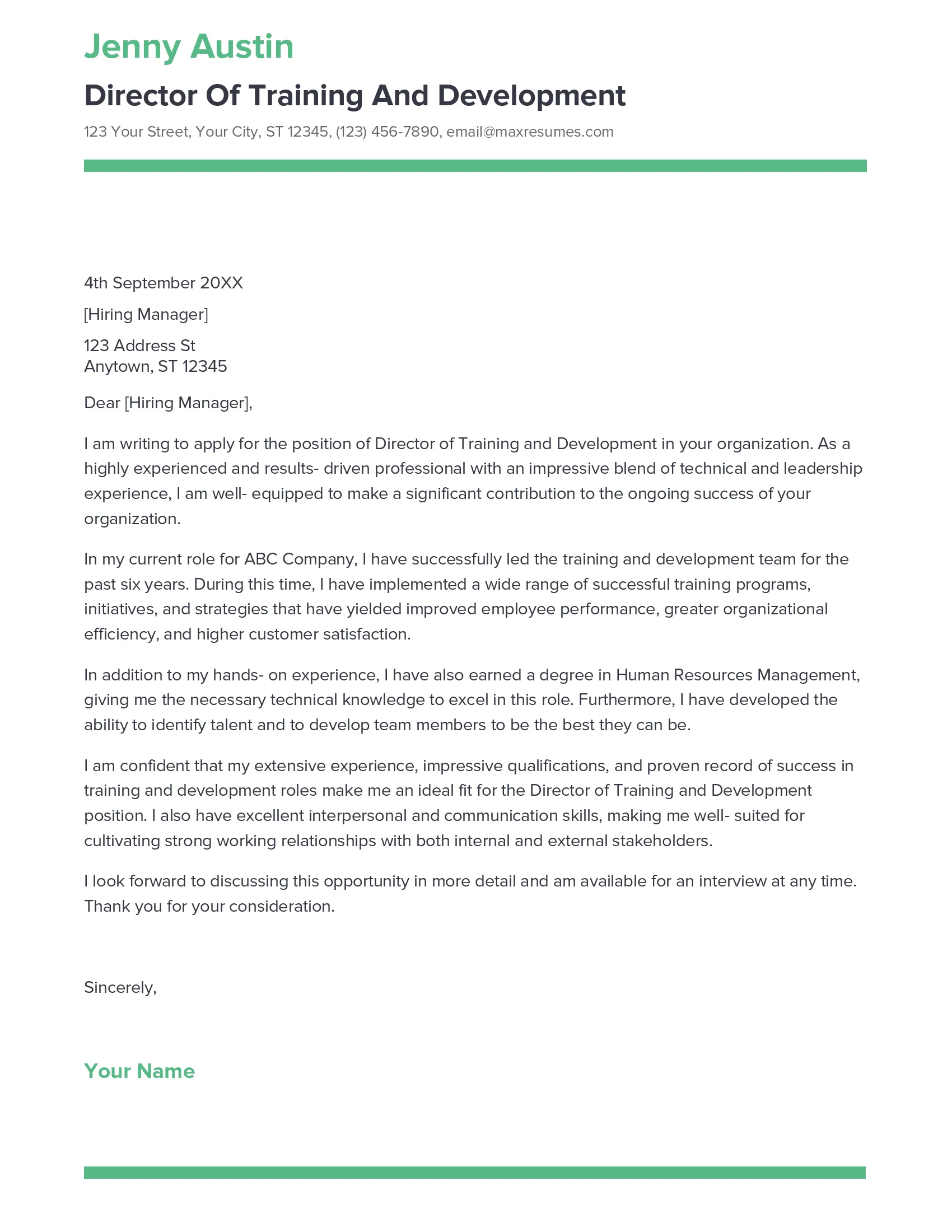
Include a clear call to action. Let the hiring manager know that you are looking forward to discussing your qualifications further. Encourage them to contact you for an interview. Mentioning that you are available at their earliest convenience reinforces your interest in the position. Provide your contact information again, making it easy for the hiring manager to reach out. This proactive approach will increase your chances of getting a response.
Closing
The closing of your cover letter is an important part of the document, as it leaves the final impression on the hiring manager. Keep it professional, concise, and reflective of the tone established throughout the letter. A well-written closing can reinforce your enthusiasm and make your application memorable.
Formal Closings
Use formal closings such as “Sincerely,” “Best regards,” or “Thank you for your consideration.” These closings maintain a professional tone. Avoid casual closings like “Cheers” or “Best.” The closing should complement the overall professionalism of the cover letter. Choose a closing that aligns with the tone of the letter and demonstrates respect. Your goal is to create a positive and lasting impression.
Signature
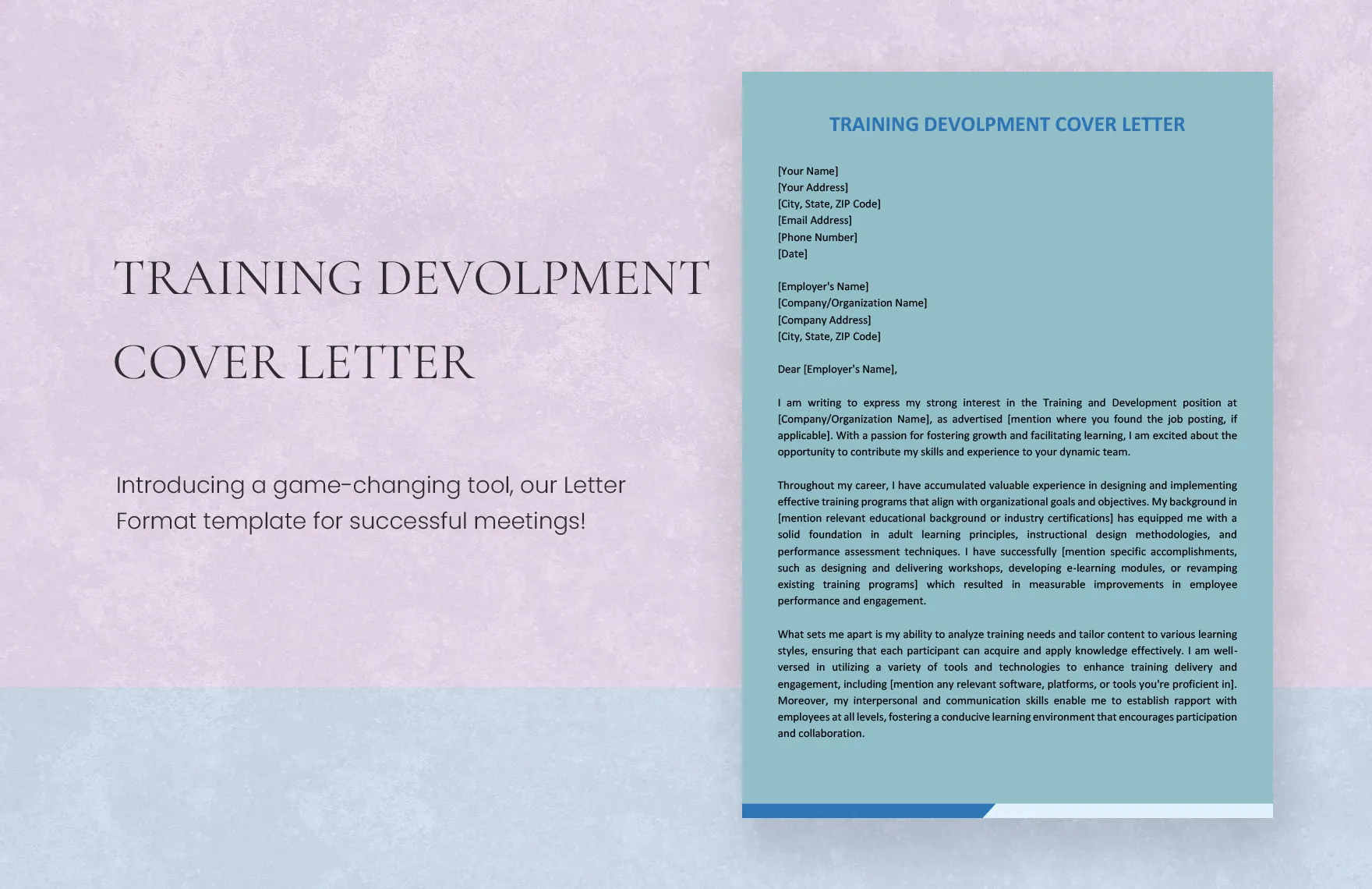
If you are sending your cover letter as a printed document, leave space for your handwritten signature between the closing and your typed name. For digital submissions, you can simply type your full name. Ensure that your signature is legible and professional-looking if you are sending a printed letter. A professional signature adds a personal touch and increases the credibility of your cover letter.
Formatting and Style
Formatting and style contribute to the overall presentation of your cover letter. A well-formatted cover letter is easy to read and visually appealing, which demonstrates your professionalism and attention to detail. Pay close attention to your font choice, margins, spacing, and overall layout. A well-structured document is crucial for making a positive impression.
Font and Font Size
Choose a professional and easy-to-read font such as Times New Roman, Arial, or Calibri. Keep the font size between 10 and 12 points. Ensure that the font choice is consistent throughout the document. Avoid using overly decorative or unconventional fonts, as these can make the letter difficult to read. Proper font selection ensures that your cover letter is accessible and professional.
Margins and Spacing
Use standard one-inch margins on all sides of the document. Use single-spacing within paragraphs and double-spacing between paragraphs. Properly formatted margins and spacing create a clean and uncluttered layout. This helps the reader focus on the content. Consistent spacing enhances readability and makes your letter more visually appealing. Proper formatting is crucial for making a strong first impression.
Proofreading and Editing
Proofread and edit your cover letter multiple times to catch any errors in grammar, spelling, and punctuation. Ask a friend or career counselor to review your cover letter for feedback. Ensure that your cover letter is free of errors, as mistakes can create a negative impression. Proper editing demonstrates attention to detail and professionalism. Proofreading and editing show your commitment to quality and a great work ethic.
Tips for a Winning Cover Letter
Crafting a winning Training and Development cover letter requires more than just listing your qualifications. By following these tips, you can create a cover letter that stands out and effectively showcases your skills and experience. Tailor your letter to each job description, research the company, and demonstrate your understanding of their needs. This personalized approach will significantly increase your chances of success.
Researching the Company
Before you start writing, research the company you are applying to. Understand their mission, values, culture, and recent initiatives. Visit their website, read their social media posts, and see if you know anyone who works there. Tailoring your cover letter to the company’s specific needs demonstrates that you’ve done your homework. This allows you to align your skills and experiences with their requirements and express genuine interest. The more you understand the company, the better you can position yourself as a strong candidate.
Tailoring to the Job Description
Customize your cover letter to match the specific requirements of the job description. Carefully review the job posting and identify the key skills and qualifications that the employer is looking for. Use the keywords from the job description throughout your cover letter, and provide specific examples of how you have demonstrated those skills in the past. This targeted approach demonstrates that you understand the role and are a great fit for the position. Always prioritize the most critical requirements mentioned in the job description.
Highlighting Relevant Experience
Focus on highlighting the relevant experiences that align with the job requirements. Select the most relevant experiences and accomplishments from your resume and elaborate on them in your cover letter. Use the STAR method (Situation, Task, Action, Result) to describe your experiences. This technique helps you provide a clear and concise explanation of your achievements. Emphasize how your past experiences have prepared you for the role you are applying for.
Showcasing Soft Skills
While hard skills are important, don’t forget to showcase your soft skills. Include examples of your communication, teamwork, problem-solving, and leadership abilities. Soft skills are critical in training and development, as they are necessary for working effectively with others. Use the cover letter to demonstrate your ability to collaborate, lead, and motivate others. Providing specific examples makes your soft skills more believable and impactful.
Reviewing and Revising
Review and revise your cover letter multiple times. Ensure that your cover letter is free of errors and tailored to the specific job description. Ask a friend or career counselor to review your letter for feedback. Fresh eyes can catch mistakes that you may have missed. Make sure to tailor your cover letter for each job application, avoid using a generic template. Reviewing and revising improves the quality of your letter.
Common Mistakes to Avoid
Avoiding common mistakes will significantly improve your cover letter and increase your chances of landing an interview. Being aware of these pitfalls allows you to present a polished and professional cover letter. These mistakes can create a negative impression and undermine your application, so be mindful of them throughout the writing process. A well-prepared cover letter showcases your attention to detail and professionalism.
Typos and Grammatical Errors
Typos and grammatical errors are a major turn-off. Always proofread your cover letter carefully, and consider having someone else review it. Make sure to use a grammar checker. Typos and errors suggest a lack of attention to detail. Proofreading ensures that your cover letter is polished and professional. A clean, error-free cover letter reflects your attention to detail and professionalism.
Generic Content
Avoid using generic content. Tailor your cover letter to the specific job and company you are applying to. Demonstrate that you understand the role and the company’s needs. Generic cover letters lack personality and show a lack of effort. Customize your letter to show that you’ve put in the extra effort. Personalize your letter by highlighting your interest in the role and mentioning the company’s specific objectives.
Exceeding Length Limits
Keep your cover letter concise and focused. Hiring managers often have to read many applications, so they don’t have much time to spend on each one. Aim for one page. A lengthy cover letter can lose the reader’s attention. Concise cover letters are more likely to be read and make a lasting impact. Sticking to the length limits ensures that the hiring manager will read all of the important content in your cover letter.
Conclusion
A well-crafted Training and Development cover letter is a powerful tool that can significantly enhance your job application. By following these guidelines and avoiding common mistakes, you can create a compelling cover letter that effectively showcases your qualifications and increases your chances of landing an interview. Remember to always tailor your cover letter to the specific job description and company. A personalized, professional cover letter can make the difference between getting an interview and getting passed over. Good luck with your job search!
